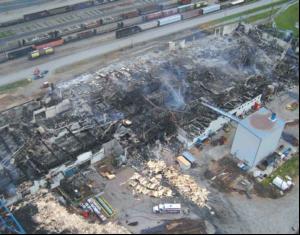A health and safety issue related to the operation of
thermal fluid systems has come to light.With an
estimated 4,000 UK companies operating such systems,
this needs urgent attention, says HTS
Health & safety incidentA health and safety issue related to the operation of
thermal fluid systems has come to light.With an
estimated 4,000 UK companies operating such systems,
this needs urgent attention, says HTS
Health & safety incidents relating to
thermal fluid systems can be
extremely serious in nature and
are more common than many people
think. The HSE recently issued a
prohibition notice to a UK company
following a major thermal fluid incident
and significantly, following that incident,
has identified thermal fluid systems as a
fire and explosion hazard. There have been
other serious incidents elsewhere this year
including a thermal fluid-related explosion
and fire at a German panel products
plant which tragically caused 3 fatalities.
As specialists in thermal fluid systems for
15 years, Heat Transfer Systems believes
that most companies will be aware that
any system that operates above the flash
point of the thermal fluid falls under the
"Dangerous Substances and Explosive
Atmosphere" (DSEAR) Regulations 2002.
However, many people are unaware that all
heat transfer fluids degrade over time. This
degradation can cause the fluid's flash point
to decrease dramatically, so that thermal
fluids which were not flammable at the
operating temperature when they were
initially installed may, over time, become
flammable at the operating conditions.
The DSEAR regulations require that the
risk from dangerous substances
(flammable materials) is assessed and
eliminated or reduced. Systems need to be
put in place to reduce the risk and manage
the residual risk. The ATEX directives
require the hazardous areas to be identified.
Regular thermal fluid testing and the
results obtained will indicate the physical
condition of the fluid and the degree of risk
in the event of a fluid release. However, flash
point testing alone is not enough to comply
with DSEAR. Procedures are also needed to
change out the thermal fluid, or remove the
lower flash point components from the
thermal fluid. HTS is concerned that the
majority of companies operating thermal
fluid systems may not be aware of this.
From HTS' experience of systems both
in the UK and across Europe, many
thermal fluid systems will have Zone 2
hazardous areas as defined under the
"ATEX Directive" (1999/92/EC). As such,
area classification is required to determine
the location and extent of the hazardous
areas, together with a full risk assessment
to identify the fire or explosion hazards
and any actions required to reduce the
risk, which must include specialist
training for relevant employees. As Alison
McKay of PROjEN explained,
"Hazardous areas can be present not just
where a fluid is handled above its flash
point. If the thermal fluid is handled under
pressure a mist or spray can be formed,
which can form an explosive atmosphere at
temperatures below the flash point".
PROjEN has been working with HTS
to designate the hazardous areas in thermal
fluid systems. PROjEN has considerable
experience in determining hazardous areas
for a wide range of processes, including
systems handling natural gas, using the
recognised standards (BS EN 60079-10-1
and IP15). PROjEN also has extensive
experience of carrying out DSEAR Risk
Assessments to determine the level of fire
or explosion risk and making
recommendations to reduce the risk.
Using the DSEAR risk assessment,
elimination and mitigation methodologies
will give owners greater comfort that they
are operating their systems as safely as
possible and will have the added benefit of
being a qualitative approach that
demonstrates good risk management to
their insurers.
Richard Franklin of HTS believes that
historically, there has been little
regulation regarding the majority of
manufacturing installations using thermal
fluids: "Most systems operate in liquid
phase with a pressurisation of below 0.5
bar (g) and as such are exempt from
inspection under the Pressure Equipment
Directive (97/23/EC). The majority of
European installations have used a
German standard under DIN 4754 (1994-
09) - Heat transfer systems operating with
organic heat transfer media - Safety
requirements and testing. At the same
time, most thermal fluid heaters are
excluded from the ATEX directive as
appliances that burn gaseous fuels and are
regulated under 90/396/EEC.
Of greatest significance is that the
process and pipeline systems that these
heaters service are not exempt. This means
that the majority of system users are not
aware of their responsibilities under
ATEX. Also, many system designers and
suppliers across Europe are not aware of
their responsibilities, and we believe could
be handing over systems following
commissioning without the required risk
assessments, training and documentation.
"As compliance was required by the 1st
July 2006 the industry needs to play catch
up. It is a great shame that it has taken a
number of incidents to bring the industry
safety shortfall to the attention of
operators, engineers, insurance companies
as well as the HSE."


